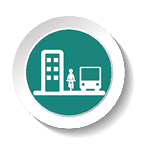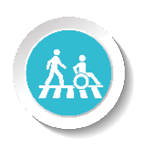Home / Implementation Strategy / 1 Short Term Actions
Implementation Strategy
Table of contents
1 short term actions

The following tables identify short-term action necessary to implement the Plan’s policies, projects and programs within the next five years. The table includes recommendations organized by goal, suggested action to implement that recommendation, identifies the type of action (Regulatory Change, Supportive Policies, Recommended Projects & Programs, Public Investment, Other City Initiatives, Strategic Partnerships), designated lead, and designated support.
Goal 1: 10-Minute Neightborhoods

All Charlotte households should have access to essential amenities, goods, and services within a comfortable, tree-shaded 10-minute walk, bike, or transit trip by 2040. Not all neighborhoods are expected to include every essential amenity, good, or service, but every resident should have access within a ½ mile walk or a 2-mile bike or transit ride.
| Recommendation | Suggested Action | Type | Lead | Support |
|---|---|---|---|---|
| Implement complete neighborhood policies that encourage mixes of different types of uses, depending on the development’s context (applies to Neighborhood Center, Neighborhood 1, and Neighborhood 2) | Incorporate into UDO | Regulatory Change | Charlotte Planning, Design & Development | All City Departments |
| Develop strategies, potentially including financial incentives or through Community Benefit Agreement, to encourage inclusion of full-service grocery stores in new mixed-use development and within areas in the city that are deemed to be food deserts where healthy produce and meats are not available | Incorporate strategies that utilize the Healthy Foods Action Plan | Other City Initiatives | Charlotte Planning, Design & Development | Economic Development, Mecklenburg County |
| Ensure the implementation of 10-minute neighborhood development policies align with the Stormwater Master Plan, promote the health of stormwater features (creeks, wetlands, stream buffers, floodplains, and drainage infrastructure) and seek opportunities to reduce costs and maintain stormwater management objectives | 1. Evaluate proposed impact from 10-minute neighborhood development policies outline in the comprehensive plan. 2. Create strategies to mitigate any negative consequences from proposed policies | Other City Initiatives | Storm Water Services | Mecklenburg County LUESA |
Goal 2: Neighborhood Diversity and Inclusion

Charlotte will strive for all neighborhoods to have a diversity of housing options by increasing the presence of middle density housing (e.g. duplexes, triplexes, fourplexes, townhomes, accessory dwelling units, and other small lot housing types) and ensuring land use regulations allow for flexibility in creation of housing within neighborhoods.
| Recommendation | Suggested Action | Type | Lead | Support |
|---|---|---|---|---|
| Work toward reducing or removing barriers identified in the ADU Report and Charlotte Housing Framework report regarding missing middle housing and evaluate development regulations, such as required lot sizes, clustered home development, conservation overlay districts, and other tools to reduce barriers | Update zoning standards as part of UDO to provide more opportunities for missing middle housing and incorporate recommendations found in ADU Report | Supportive Policies | Charlotte Planning, Design & Development | Housing & Neighborhood Services |
| The Group/Commission will launch an anti-displacement study and recommend tools and strategies for protecting residents of moderate to high vulnerability of displacement. Using Commission recommendations, Council may adopt an Anti-Displacement Strategy focusing on vulnerable neighborhoods | Collaborate with UNC-Charlotte to develop a methodology and strategy for measuring involuntary displacement and Naturally Occurring Affordable Housing (NOAH) in Charlotte | Strategic Partnerships | Charlotte Planning, Design & Development | UNC Charlotte |
Goal 3: Housing Access for All

Charlotte will strive for all neighborhoods to have a diversity of housing options by increasing the presence of middle density housing (e.g. duplexes, triplexes, fourplexes, townhomes, accessory dwelling units, and other small lot housing types) and ensuring land use regulations allow for flexibility in creation of housing within neighborhoods.
| Recommendation | Suggested Action | Type | Lead | Support |
|---|---|---|---|---|
| Use the Place Type Manual (in the Manuals and Metrics) to guide design transitions within neighborhoods to more intense use types that can accommodate affordable and workforce housing | Ensure Future Place Type Mapping is consistent with future zoning districts and vice versa | Community Area Planning | Charlotte Planning, Design & Development | Housing & Neighborhood Services |
| Coordinate and streamline existing programming that aids homeowners who desire to stay in their homes | Create recommendations to streamline existing programs and implement them | Support for Homeownership | Housing & Neighborhood Services | Charlotte Planning, Design & Development |
| Include provisions similar to the Bonus Menu included in the TOD Zoning Ordinance in some or all new zoning districts associated with Neighborhood 2, Community Activity Center and Regional Activity Center Place Types | Update bonus provisions developed for TOD districts and incorporate into the UDO | Regulatory Changes | Charlotte Planning, Design & Development | Housing & Neighborhood Services |
| Develop market-focused regulatory and administrative changes to encourage production of affordable housing | Lead the charge to pass enabling legislation for State Tax Credit Programs and expanding Federal Low-Income Housing Tax Credit (LIHTC) Programs and eligibility in coordination with local, state, and Federal partners to facilitate and spur the development of affordable housing | Regulatory Changes | Charlotte Planning, Design & Development; Housing & Neighborhood Services | North Carolina; Housing and Urban Development; and other state, local, and federal partners |
| Provide zoning incentives for mixed-income developments | Incorporate incentives for mixed income housing into UDO | Recommended Projects and Programs | Charlotte Planning, Design & Development | Housing & Neighborhood Services |
| Support an increased Housing Trust Bond Allocation to expand programs and develop more units | Explore an increase in allocation to the Housing Trust Fund in future bond cycles | Support for Homeownership | Housing & Neighborhood Services | Charlotte Planning, Design & Development |
| Consider working with the County to develop new programs to mitigate the impacts of rising property values on lower-income households, particularly in neighborhoods where housing costs are rapidly appreciating | Explore the establishment of a fund for land banking strategies around new transit investment | Support for Homeownership | Housing & Neighborhood Services | Charlotte Planning, Design & Development |
Goal 4: Transit and Trail Oriented Development (2T-OD)

Charlotte will promote moderate to higher-intensity, compact, mixed-use urban development along high-performance transit lines and near separated multi-use pathways or trails.
| Recommendation | Suggested Action | Type | Lead | Support |
|---|---|---|---|---|
| Develop a scorecard system for prioritizing in the Capital Improvement Plan (CIP) bicycle, pedestrian, and other active mode capital improvements for communities that have limited accessibility and connectivity | Revise the City’s method for evaluating and prioritizing potential transportation projects in the Capital Improvement Plan (CIP) to focus more on equity and active transportation | Recommended Projects and Programs | Charlotte Planning, Design & Development | Housing & Neighborhood Services |
| Prioritize equitable TOD (E-TOD) along high-performance transit and trail corridors | Prioritize anti-displacement tools and affordable housing investment along transit and trail corridors in neighborhoods vulnerable to displacement | Recommended Projects and Programs | Charlotte Planning, Design & Development | Housing & Neighborhood Services |
| Work with CATS and Housing, Neighborhood Services, and other local and regional partners to leverage park and ride locations, as well as surplus parking to provide equitable TOD opportunities | Evaluate CATS Park and Ride locations for opportunities to leverage surplus space and parking for affordable housing | Recommended Projects and Programs | Charlotte Planning, Design & Development | Charlotte Area Transit System (CATS); Housing & Neighborhood Services |
Goal 5: Safe and Equitable Mobility

Charlotte will provide safe and equitable mobility options for all travelers regardless of age, income, ability, race, where they live, or how they choose to travel. An integrated system of transit and tree-shaded bikeways, sidewalks, trails, and streets will support a sustainable, connected, prosperous, and innovative network that connects all Charlotteans to each other, jobs, housing, amenities, goods, services, and the region.
| Recommendation | Suggested Action | Type | Lead | Support |
|---|---|---|---|---|
| Develop and regularly update a Strategic Mobility Plan, that establishes a comprehensive and prioritized strategy of mobility projects and programs to implement the shared goals and policies of the Comprehensive Plan | Develop the Strategic Mobility Plan and associated CIP prioritization process for transportation project | Recommended Projects & Programs | Charlotte Department of Transportation (CDOT) | Charlotte Planning, Design & Development |
| Prioritize the safety and comfort of travelers in all modes when planning and implementing mobility projects and focus safety investments on the “high injury network”, the 10% of Charlotte streets that account for 100% of serious injury and fatal crashes | Identify an expanded program of Vision Zero investment that will prioritize traveler safety and comfort along the City's “high injury network” | Supportive Policies | Charlotte Department of Transportation (CDOT) | General Services |
| Include in the development regulations an integrated Traffic Impact Study (TIS) / Transportation Demand Management (TDM) program that requires development and redevelopment projects that meet an established threshold to evaluate and address the multi-modal transportation impacts of the development | Implement an updated TIS / TDM regulatory and policy framework | Supportive Policies / Regulatory change | Charlotte Department of Transportation (CDOT) | Charlotte Planning, Design & Development; General Services |
| Define transportation equity and develop quantitative equity metrics to guide the prioritization of programs and projects that ensure that people of all ages, abilities, and backgrounds have access to high-quality, affordable transportation choices | Define quantitative equity metrics to guide project and program prioritization particularly to inform the CIP prioritization program for transportation projects | Supportive Policies | Charlotte Department of Transportation (CDOT) | Charlotte Planning, Design & Development; General Services |
| Transit Bus Priority Corridors: Implement transit priority and high-frequency service on key corridors | Pilot/implement Transit Bus Priority on key test corridors, and identify an expanded program of Vision Zero Investments that will prioritize traveler comfort and safety along the City’s “high injury network” | Recommended Projects & Programs | Charlotte Department of Transportation (CDOT) & Charlotte Area Transit System (CATS) | Charlotte Planning, Design & Development; General Services |
Goal 6: Healthy and Active Communities

All Charlotteans will live and work in safe and resilient neighborhoods that enable healthy and active lifestyles by reducing exposure to harmful environmental contaminants, expanding and improving the quality of tree canopy cover, encouraging neighborhood investment in walking, cycling, and recreation facilities, and providing access to healthy food options and health care services.
| Recommendation | Suggested Action | Type | Lead | Support |
|---|---|---|---|---|
| Invest in programs that address social determinants of health conditions (e.g., tobacco use, substance abuse, domestic violence, and other determinants) targeting neighborhoods that are the most vulnerable | Define most vulnerable neighborhoods and identify programs that will address social determinants of health conditions | Public Investments | Mecklenburg County Health Department | Housing & Neighborhood Services |
| Coordinate economic development and brownfield remediation efforts to encourage cleanup and redevelopment of brownfield sites | Implement Brownfield Grant Program | Public Investments | Economic Development | Office of Sustainability & Resiliency |
| Develop preventative programs and community events designed to promote improved health and wellness decision-making | Define and implement programs to promote improved health and wellness decision-making | Recommended Projects & Programs | Mecklenburg County Health Department | Charlotte Communication & Marketing |
| Work with City and community partners to develop a Public Space Master Plan that identifies opportunities for parks, plazas, and other public spaces | Create a Public Space Master Plan that addresses access to existing and opportunities for new parks, plazas, and public spaces | Recommended Projects & Programs | Charlotte Planning, Design & Development | Mecklenburg County Park and Recreation |
Goal 7: Integrated Natural and Built Environment

Charlotte will protect and enhance its surface water quality, tree canopy, and natural areas with a variety of trees, plantings, green infrastructure, green building practices, and open space at different scales throughout the entire community as a component of sustainable city infrastructure that addresses the threat of climate change.
| Recommendation | Suggested Action | Type | Lead | Support |
|---|---|---|---|---|
| Establish new partnerships and expand existing partnerships with Mecklenburg County, community organizations, and nonprofits to secure support and development of new and existing parks and shared-use paths, including small parks in or near different neighborhoods, and the protection of open spaces | Continue to expand and build partnerships among local and regional organizations concerning sustainability, resiliency, and open spaces | Strategic Partnerships /Supportive Policies | Mecklenburg County Park and Recreation | General Services |
| Continue working with Mecklenburg County Land Use and Environmental Services Agency within shared watersheds to set resiliency policies, establish implementation programs, and implement consistent regional standards to manage change within watersheds. Use the Charlotte-Mecklenburg All Hazards Plan and future County stormwater residual flood risk goals to guide these efforts | Work with neighboring jurisdictions during community planning efforts to establish resiliency policies and implement consistent regional standards, with the goal of reducing flood risk | Strategic Partnerships /Supportive Policies | Fire Department - Emergency Management | Mecklenburg County Land Use & Environmental Services Agency (LUESA) |
| Update development regulations to better mitigate impacts from development and infill development such as stormwater runoff and tree removal | Utilize UDO regulations to ensure that infill development does not lend itself to increased stormwater issues, runoff and a decreased tree canopy | Regulatory Changes | Charlotte Planning, Design & Development | Storm Water Services |
| Continue to require development of publicly accessible shared-use path sections that connect the City’s network through private developments and change private development standards to ensure that sections on private lands are constructed to meet public standards | Identify most desirable amenities as part of greenway accessibility in private developments and remain consistent in requiring development of greenways in private developments | Regulatory Changes | Charlotte Planning, Design & Development | Mecklenburg County Park and Recreation |
| Continue to preserve and protect tree canopy on City-owned properties and consider implementation of a tree planting program on City-owned properties available for public use, such as the Urban Arboretum Trail and Program | Analyze current efforts to plant trees on city property | Public Investments | General Services | Charlotte Planning, Design & Development |
| Explore development of a climate action plan to determine specific targets and metrics for carbon footprint reduction city-wide | Work with Duke Energy and others to establish revolving funds to help finance investment needed for residential energy efficiency retrofits, to help meet the City’s SEAP goals | Strategic Partnerships /Supportive Policies | Office of Sustainability & Resiliency | Charlotte Planning, Design & Development |
| Review development regulations for opportunities to remove barriers and/or create requirements or incentives for sustainable development practices, including regulations relating to implementation of solar power through community solar arrays, electric vehicle charging stations, and battery energy storage in residential and non-residential areas | Incorporate regulatory requirements or incentives that support sustainable development practices into the UDO | Regulatory Changes | Charlotte Planning, Design & Development | Office of Sustainability & Resiliency |
| Increase sustainable and resilient building standards applicable to existing and new City owned buildings – for example, require LEED certification for new construction, solar energy generation where feasible, and net zero energy consumption | Go through appropriate channels to require LEED certification for construction of City buildings | Public Investments | General Services | Office of Sustainability & Resiliency |
| Continue to test, pilot, and document green stormwater infrastructure best management practices | Benchmark costs and effectiveness of GSI (Green Stormwater Infrastructure) and improve compliance options | Other City initiatives | Storm Water Services | Mecklenburg County Land Use & Environmental Services Agency |
| Develop a dashboard to track progress towards the City’s climate action goals | Collaborate with the public and with city departments to determine city's climate action goals | Other City initiatives | Office of Sustainability & Resiliency | Charlotte Planning Design & Development |
| Continue to transition the City to a circular economy by expanding programs that maximize product reuse and recycling and minimize waste, such as City-wide composting | Identify simple sustainable practices to encourage/require at city offices | Other City initiatives | Economic Development | Office of Sustainability & Resiliency |
| Establish programs to educate the public on how to reduce their environmental impact through sustainable practices relating to water usage, composting, fertilizers, and energy usage | Review and revise zoning policies that may keep people from pursuing sustainable practices | Recommended Projects & Programs | Office of Sustainability & Resiliency | Housing & Neighborhood Services |
| Work with the County on the development of an app that provides an interactive map of all public parks, open spaces, and trails | Establish a partnership between planning and Meck County Parks and Rec to develop a comprehensive app for all city and county parks | Recommended Projects & Programs | Mecklenburg County Park and Recreation | Information Technology |
| Implement a signage program throughout the City to provide clarity for shared use path and park connections | Identify through analysis (qual/quant) which parks/greenways would best benefit from a signage program | Recommended Projects & Programs | Charlotte Department of Transportation (CDOT) | Charlotte Planning, Design & Development |
| Modify development regulations for zoning districts associated with neighborhoods to provide publicly accessible open spaces as part of private developments | As part of UDO implementation, require private developments to provide a certain percentage of public open space | Regulatory Changes | Charlotte Planning, Design & Development |
Goal 8: Diverse and Resilient Economic Opportunity

Charlotteans will have opportunities for upward mobility to align education and skill levels with a diverse mix of employment opportunities, especially in targeted and supported industries.
| Recommendation | Suggested Action | Type | Lead | Support |
|---|---|---|---|---|
| Continue leadership role in regional efforts to support economic development with further emphasis on defined roles and responsibilities for the City, regional partners, and the state. Focus City efforts on project based business attraction/retention opportunities within target industries, investments in place-based economic development efforts and partner with place-management organizations that implement them, support for Minority, Women, and Small Business Enterprises (MWSBEs), and support for workforce development efforts by providing resources and connecting training providers to residents and businesses | Define ED leadership roles and responsibilities among city and regional partners | Strategic Partnerships | Economic Development | Mecklenburg County Economic Development |
| Grow and promote the greater airport to support their master planning efforts | Ensure Future Place Type Mapping and Community Area Planning leverages opportunities around the airport; Align Future Place Type mapping with mapping of Zoning Districts to ensure that there are few barriers to the growth of the greater airport area as a hub | Community Area Planning; Strategic Partnerships | Charlotte Planning, Design & Development; Aviation | Economic Development |
| Explore policies and programs, such as Community Benefit Agreements, to support the development of new and retention of community assets and amenities (such as existing childcare facilities in or near major employment centers | Research application of Community Benefits Agreements | Other City initiatives | Charlotte Planning Design & Development | Economic Development |
Goal 9: Retain Our Identity and Charm

Charlotte will retain the identity of existing neighborhoods by intentionally directing redevelopment, limiting displacement and cultivating community-driven placemaking that elevates the importance, quality and design of places.
| Recommendation | Suggested Action | Type | Lead | Support |
|---|---|---|---|---|
| Explore implementation of “neighborhood character” overlay zoning in appropriate neighborhoods to reduce or mitigate changes to community character, while balancing needs to diversify the City’s housing stock | Draft and include Neighborhood Character Overlay District standards in the Unified Development Ordinance | Recommended Projects & Programs | Charlotte Planning, Design & Development | Historic Districts Commission |
| Develop a community design handbook to guide redevelopment of Charlotte’s historic neighborhoods and other cherished places | Complete update for Historic District Guidelines to include Multifamily and Commercial Structures | Recommended Projects & Programs | Charlotte Planning, Design & Development | Historic Districts Commission |
| Develop preservation plans that identify places, traditions, landscapes, and buildings that tell the full story of the City’s history and outline future direction for celebrating and enhancing the unique physical character, cultural values, and social identity of the City | Work with interested neighborhoods to implement additional historic districts building on the success of Oaklawn Park | Other City initiatives | Charlotte Planning, Design & Development | Historic Districts Commission |
| Finalize the Route 4 Survey project to support planning efforts as well as lead to local historic landmark and district designations, conservation district designations, and National Register nominations | Complete Phases III, IV, and V, intensive-level architectural investigations | Recommended Projects & Programs | Charlotte Planning, Design & Development | Historic Districts Commission |
| Increase the number of publicly funded art and placemaking installations within vulnerable neighborhoods | Grow the Placemaking Technical Assistance Grant to include neighborhoods vulnerable to displacement | Recommended Projects & Programs | Charlotte Planning, Design & Development | Economic Development; Arts and Science Council (ASC) |
| Mitigate neighborhood-defined cultural displacement through support and incentives for local businesses, markets, and community amenities and funding to support placemaking and artwork placed through the City’s Public Arts Program (enabled by the Public Art Ordinance) | Start a Technical Assistance Grant Program within the Corridors of Opportunity Program and implement quick win projects through Placemaking CIP funding | Recommended Projects & Programs | Charlotte Planning, Design & Development | ASC |
| Cultivate placemaking and local culture by continuing to fund the Placemaking Program | Expand the Placemaking Program to build urban public spaces | Recommended Projects & Programs | Charlotte Planning, Design & Development | Economic Development |
| Promote the reuse and redevelopment of under-used surface parking lots to support the expansion and creation of local businesses | Reuse parking for outdoor dining and retail for businesses by growing the Outdoor Dining Temporary Guidelines put in place during COVID-19 to a permanent Outdoor Dining Program | Recommended Projects & Programs | Charlotte Planning, Design & Development | Economic Development, Housing and Neighborhood Services, CDOT |
| Develop a fund for the maintenance and programming of public spaces | Complete and open space analysis that looks at all city-owned and operated public spaces and resources needed to program, maintain, and manage them | Public Investments | Charlotte Planning, Design & Development | Economic Development |
| Develop a fund for the maintenance and programming of public spaces | Establish a Maintenance Program for City-led and community Placemaking Programs by incorporating an on-going maintenance/repair and programming budget for Placemaking projects | Public Investments | Charlotte Planning, Design & Development | Economic Development, Housing and Neighborhood Services, CDOT |
| Develop vacant properties registry and work with property owners to evaluate and encourage beneficial reuse of sites | Add to the current citywide inventory and create criteria for potential uses: Public Space, Affordable Housing, Tree Canopy, etc. | Recommended Projects & Programs | General Services – Real Estate | Planning, Design and Development, Economic Development, Housing and Neighborhood Services, CDOT |
Goal 10: Fiscally Responsible

Charlotte will align capital investments with the adopted growth strategy and ensure the benefits of public and private sector investments benefit all residents equitably and limit the public costs of accommodating growth.
| Recommendation | Suggested Action | Type | Lead | Support |
|---|---|---|---|---|
| Develop programs to require that all costs of utility extension be fairly allocated to the development, to encourage efficient growth that minimizes utility extension costs (e.g. Charlotte Water) | Research potential of Community Benefit Agreements / Impact Fees | Supportive Policies | Charlotte Planning, Design & Development | Charlotte Water |
| Analyze and plan for infrastructure and utility needs in areas identified as play Place Types (e.g. Regional and Community Activity Centers) or where additional infill and redevelopment will be encouraged | Develop Comp Plan CIP Lookbook updating the Capital Needs Assessment | Supportive Policies | Charlotte Planning, Design & Development | Strategy & Budget; Charlotte Water; Storm Water Services |
| Perform an economic impact analysis prior to the implementation phase of the Plan | Develop and implement specific scope for economic impact analysis | Supportive Policies | Charlotte Planning, Design & Development | Chief Economist, Strategy & Budget |
| Empower neighborhoods and businesses districts to aid in the development of Capital Improvement Plan and Bond projects | Pilot a participatory budget process in East or West Charlotte | Supportive Policies | Chief Economist, Strategy & Budget | Charlotte Planning, Design & Development |
